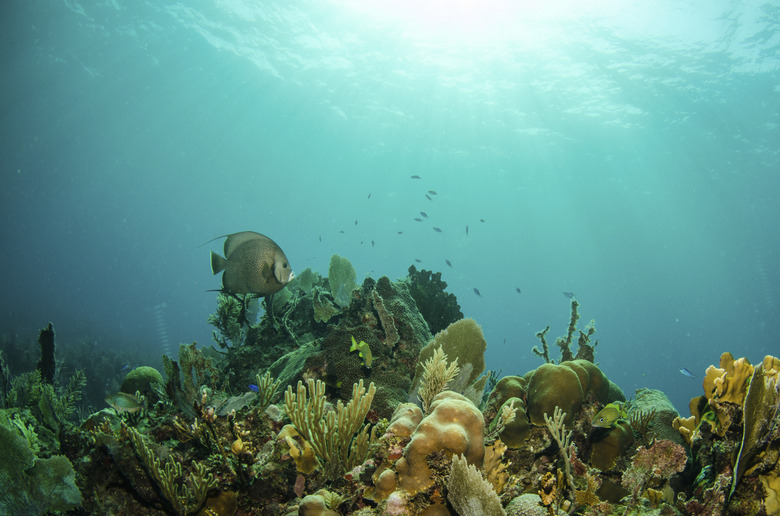How Have Plants Adapted To The Coral Reef To Survive?
Coral reefs are the calcified marine structures formed by the exoskeletons of corals, and the three main kinds of plants that interact with coral reefs are algae, seagrasses and mangroves, with the algae being divided into red and green varieties. Many of these marine plants benefit the coral reefs. Coral reef ecosystems also include a wide range of fauna and are some of the most vibrant ecosystems on Earth.
Red Algae and Coral Reefs
Red Algae and Coral Reefs
A certain type of red algae called coralline algae can have a major role in boosting the stability of a coral reef. Coralline algae deposits protective calcium in its cell walls, and these encrusted algae act to cement together various corals, enhancing the reef's structure. Geniculate corallines have an encrusted tree-like structure that is somewhat flexible because of the presence of some uncalcified areas. Nongeniculate corallines are slow-growing crusts that can affix to rocks, shells, other algae and seagrasses, in addition to corals.
Green Algae and Coral Reefs
Green Algae and Coral Reefs
Green algae comprise another group of marine plants that have adapted to survive on corals reefs. In fact, coral green algae are so successful in certain areas that they are actually becoming a threat to their hosts. When the relationship between a coral reef and green algae is in balance, the algae grow on the reef and provide food to grazing fish. However, when a large influx of nutrients arrives in the form of coastal wastewater, the algal community becomes supercharged, explodes in size and consequently reduces the presence of bacteria that are beneficial to the corals while fostering the growth of harmful bacteria.
Seagrasses and Coral Reefs
Seagrasses and Coral Reefs
As part of an important ecological three-way interaction with coral reefs and mangroves, seagrasses tend to thrive in coastal habitats. Waters sheltered from ocean waves by coral reefs allow seagrasses to take root, and in return seagrasses slow down and trap sediments, preventing the sediment load in the water from becoming too high for corals to survive. Seagrass meadows can contain several different species, and they only reach depths that the demands of photosynthesis allow.
Mangroves and Coral Reefs
Mangroves and Coral Reefs
Like seagrasses, mangroves flourish as a result of the protection from violent ocean waves offered by coral reefs. Mangroves benefit both seagrasses and coral reefs primarily by mitigating shoreline erosion and thereby preventing harmful amounts of sediment from entering coastal waters. Mangrove forests also act as a buffer zone for pollution runoff, particularly nutrient-rich sewage that can disrupt the ecological balance of the coral reef–seagrass meadow–mangrove forest system. The marine roots of mangroves also act as critical nurseries for numerous coastal species of fish.
Cite This Article
MLA
Smith, Brett. "How Have Plants Adapted To The Coral Reef To Survive?" sciencing.com, https://www.sciencing.com/plants-adapted-coral-reef-survive-6173664/. 24 April 2017.
APA
Smith, Brett. (2017, April 24). How Have Plants Adapted To The Coral Reef To Survive?. sciencing.com. Retrieved from https://www.sciencing.com/plants-adapted-coral-reef-survive-6173664/
Chicago
Smith, Brett. How Have Plants Adapted To The Coral Reef To Survive? last modified March 24, 2022. https://www.sciencing.com/plants-adapted-coral-reef-survive-6173664/
